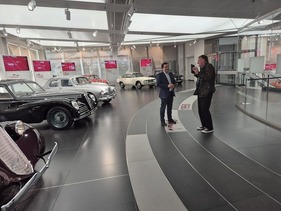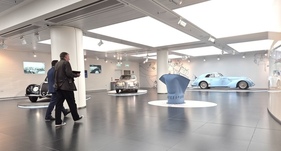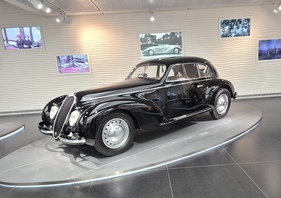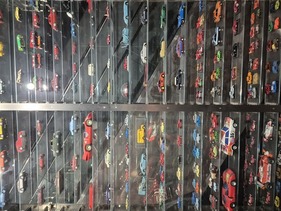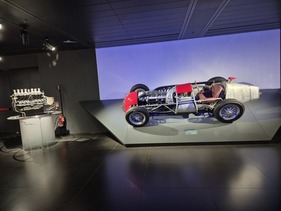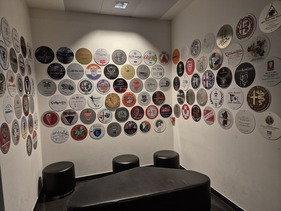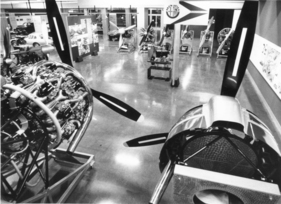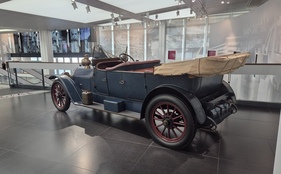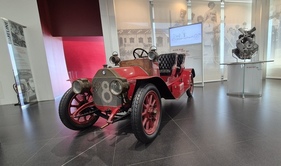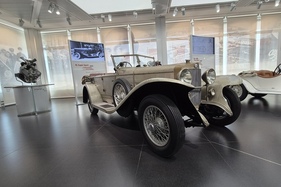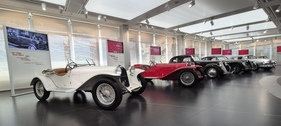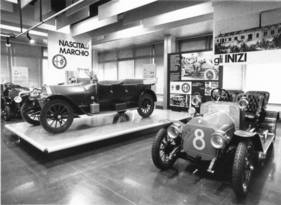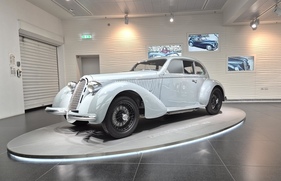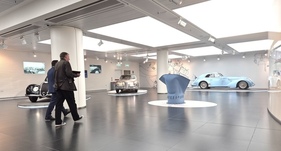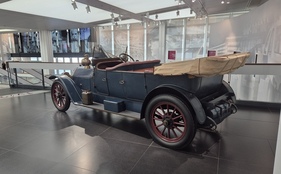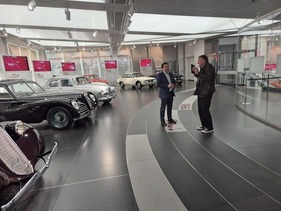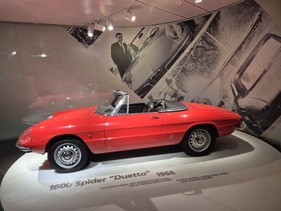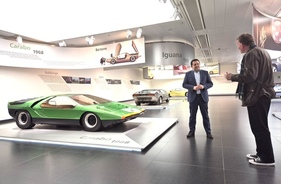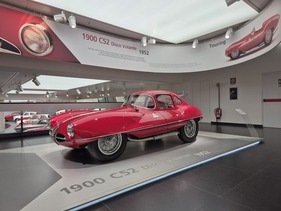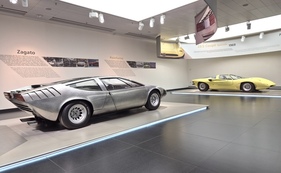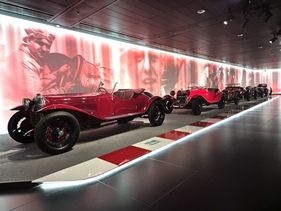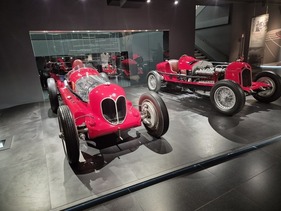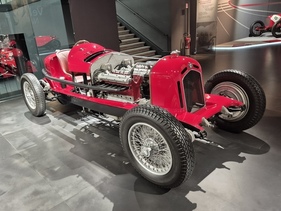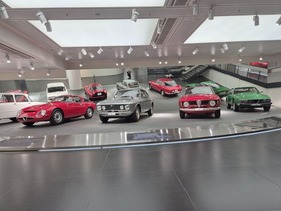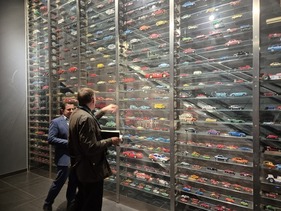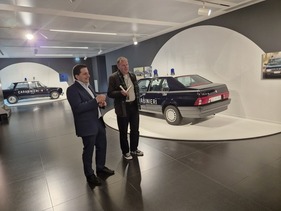The origins of the Alfa Romeo collection date back to the 1950s. At that time, the cars from the racing department and other historical witnesses were set aside as study objects. At the instigation of the then Alfa Romeo director Giuseppe Luraghi, a museum was opened in 1976 in the buildings of the factory in Arese, also initiated by Luraghi and built in the 1960s for the production of the new Giulia.
The purpose here was also primarily for study purposes and as a showcase for business partners and customers, rather than for the general public. We know this, for example, from the Conservatiore Citroën, which was closed in 2024 and could be visited by appointment, but was never considered a museum in the true sense of the word.

Well, the "Departino", as the museum is called in the overall context of Alfa Romeo, has become a long-term project for the curator, as Lorenzo Ardizio explains: "Before it closed, the museum had around 5000 visitors a year. Today, we receive up to 1000 guests on a good weekend alone. We are just about to pass the 100,000 mark per year."
But visitors were not the curator's first concern. Rather, the first task was to create the conditions that would separate the Alfa Romeo collection from the company's operational interests. It is astonishing that until 2015, the country with the most UNESCO-recognized cultural assets in the world had no mode or procedure for dealing with industrial, mobile cultural assets.
Ardizio explains: "The Turin Charter, the criteria laid down by the FIVA (Fédération internationale des Véhicules Anciens) for recording historic vehicles, are of little help here. We were concerned with the protection of cultural assets. I found the example in dealing with automobiles, engines, airplanes and so on with historic violins. A Stradivarius or Guarneri - in principle an object of daily use, not a work of art - is nevertheless subject to full protection. The Alfa Romeo collection now enjoys the same status - both for the vehicles and for the associated documentation. Only the Bertone collection from the period up to the 1960s enjoys similar protection in Italy."
As is well known, the rest is held by collector Corrado Lopresto - who is terribly upset that Italy's state has snatched up Bertone's history from its beginnings right up to the 1960s. As we all know, there are two sides to every coin.
History, beauty and speed
But back to the museum in Arese. There were around 260 vehicles to choose from. It was clear that not all of these cars would fit into the museum: "There simply needs to be space for many of these cars. I could certainly have accommodated a lot more. Fans sometimes accuse us of exhibiting too few cars. But we are not a sales exhibition, and I don't want it to look like a used car lot here either. That's why we are rather cautious with newer models in the exhibition!"
Ardizio has organized the exhibition under three main themes: "History", "Beauty" and "Speed". The "History" theme is immediately apparent in the first exhibition area. This is where the oldest representatives of the A.L.F.A., the Anonima Lombarda Fabbrica Automobili, founded by Alaxandre Darraq and Cavaliere Ugo Stella in 1910, are on display.
"The first part of the exhibition is dedicated to production cars; those cars that were seen on the road. What we are doing here is allowing visitors to slowly immerse themselves in the subject. It is important to concentrate on the essentials. There is no music here, no video screen - nothing to get your pulse racing right from the start. The cars speak for themselves. A museum that works like a film or a theater. It needs a story and this in turn needs a dramaturgy as to how it is told. Like a good story, we have ups and downs - quieter moments and moments that get you going, that get you moving emotionally," Ardizio reveals his recipe.
The oldest car in the exhibition is an A.L.F.A. 24 HP from 1910, with each subsequent decade representing a car. The last of this prelude is an 8C from 2007. "As you can see, there are no marble plinths in this museum, no over-heightening of the cars. At most, there are exactly six centimeters more than the floor on which the cars stand. Cars were drawn in such a way that they look best when they are standing flat on the ground. This was important to me. The fact that there are still small platforms helps us to communicate to visitors that they are entering a forbidden zone when they step on them. Up to here, then please stop! This prevents ugly barriers and allows an unobstructed view of our cars. There are supervisors in every exhibition hall during opening hours. However, they are not just guards, but people who know our content inside out and don't just tell visitors what they are not allowed to do, but try to make them understand what the DNA of Alfa Romeo is and why we should protect our cultural heritage. We don't want to punish curiosity, we want to encourage it!" says the curator, describing the special features of his exhibition.
Lots of light and dynamism
Lorenzo Ardizio attaches great importance to the light: "We know that, don't we? These museums with their semi-dark exhibitions. We wanted to avoid that at all costs. Of course, for dramaturgical reasons, we also have moments where you enter a relatively dark room, such as the "Alfa Romeo in film" theme. The meteriality was also important to us. There are no backdrops or anything like that. Everything you see is what it looks like - glass is glass, concrete is concrete and so on."
We enter a room dedicated to the subject of "Alfa in film". The internet database imcdb.org lists thousands of films in which an Alfa Romeo can be seen. But as Ardizio says, there are around 42 world-class productions in which a car with the biscione - the feathered snake - plays a significant role. The Graduate - German title: "Die Reifeprüfung" - with Dustin Hoffman, meanwhile, probably features the most famous film appearance of an Alfa Romeo: a red Spider Duetto. Lorenzo Ardizio also mentions Matula in the crime series "A Case for Two", who drove just about everything from the Giulia to the 159 that rolled off the production line at Alfa Romeo during the production period of no less than 300 episodes. A total of twelve different films are presented in the museum.
Alfa Romeo as a source of inspiration
A particularly spacious hall is dedicated to the design studies and masterpieces of Italian coachbuilders from the 1950s to the beginning of the new millennium. The Alfa Romeo Carabo, built by Bertone and designed by the then still young Marcello Gandini, stands right in the middle.
The Carabo brought many innovations to international car design: the hinged doors or the extreme wedge shape. Here, too, there are no screens, no music, just the cars and their aesthetics. That has to be enough. The room pays homage to the Italian coachbuilders. Cars such as the 2000 Sportiva, designed by Franco Scaglione for Bertone, or the Disco Volante from Carlo Felice Bianchi Anderloni's company Carozzeria Touring, which was designed by Federico Formenti.
The Alfa Romoeo Sprint Speciale Prototipo from Bertone, designed by Giorgetto Giugiaro, or the first "concept car" from Alfa Romeo as the museum curator says: the 40/60 HP Aerodynamica, the drop on wheels based on an idea by Count Marco Ricotti and built by Castagna. The car was commissioned from Castagna in 1913, but was very quickly converted into an open car, as the drop-shaped inner handlebars turned out to be too loud and too warm. The original was lost; the carriage shown is a replica from the 1970s.
"Value doesn't play a role here. Sure, there are extremely valuable cars in this collection, but we don't play on that theme in the museum. As you can see in the exhibition on Alfa Romeo's racing victories, the focus is also on the people. The photos and films of the nine selected racing victories - out of thousands more - primarily show the drivers involved. Even these are not glorified as heroes. We show them at work, at the races, sometimes tired and exhausted. You also see the enthusiasm of the spectators, this enthusiasm and the importance that motorsport had back then," says Lorenzo Ardizio, describing this part.
In the "catacombs" - in the inner sanctum of the museum - are the brand's racing legends: the 6C 1500 or 6C 1750 Supersport, the 8C 2300 Le Mans or even the spectacular, aerodynamically optimized 8C 2900 B Speciale Tipo Le Mans with its incredibly long hood. These are joined by the company's GP cars: the Tipo B, the Bimotore with one engine under the hood and one in the rear, or the Tipo A, in which the two six-cylinder engines sit side by side under the hood.
And of course the Alfetta can also be found here. It is also presented in such a way that it is not overly glorified. It doesn't need to be. Or perhaps a little? The Tipo 159 is the only car in the entire exhibition that is displayed slightly raised and tilted. As the bodywork has been partially removed, the underlying mechanics can be seen more clearly.
A business unit of the company
The Alfa Romeo Museum is a separate division of the company. "The collection is protected by a contract with the Italian Ministry of Culture. No, we are not a foundation. That also has important advantages. I am in good contact. We are not the odd bunch of diehards. The lines are short; I'm on the internal mailing list, so to speak, and therefore in daily contact with the management. We often serve as a source of inspiration, as a place where the DNA of Alfa Romeo can best be felt. This actually also has an impact on current products. The designers get their ideas here. The museum is not simply a place where history is stored. It is an ongoing project, something dynamic, just like the cars themselves. Incidentally, around 60 percent of the cars in the exhibitions are drivable," assures Lorenzo Ardizio when asked about the integration of the museum into the overall context of Alfa Romeo.
The curator adds: "The exhibitions are also the first layer of our collection. There is also the storage area, which is basically an in-depth level like the extensive archive. This can also be visited. The cars, engines and airplanes and everything else we have are there - not curated, but equally accessible, for example for studies and the like."
We want to know where the objects come from: "The archive items often come from donations. There are various documents, photos, films or files. These are inventoried on an ongoing basis. It is particularly important to me to deal with these things promptly. We don't have boxes full of objects that we don't know exactly what they are. We are very cautious when it comes to cars. And it doesn't necessarily have to be the first or last car in a series. I prefer cars with an individual history. These are also easier to tell. In my opinion, the first car in a series that goes straight into the museum doesn't have too much to tell. But visitors confirm to me again and again that it is precisely the anecdotes, the individual stories people have about their cars that they take home with them, not technical data or simple figures."
Lorenzo Ardizio has a very personal story to tell about the latest part of the exhibition with historic Alfa Romeos in the service of the Carabinieri: "As you know, in Italy there are these two incompatible worlds of the Polizia Statale, which is also responsible for road traffic as the Polizia Stradale, and the Carabinieri, which is part of the army. We show vehicles from the Carabinieri fleet. These are all still owned by the authority. When the news spread that some could now be seen in Arese, a good friend and commander at the Polizia called me - we have a very good relationship - and said just one word before hanging up again: "Stronzo!" We can assume that the next cars to be seen in this part will be the Polizia cars - known as "Pantera" in Italy since they were black Alfa Romeo 1900s in the early 1950s.
The Museo Storico Alfa Romeo is open daily except Tuesdays from 10:00 to 18:00. The exhibitions are accompanied in Italian and English.

















